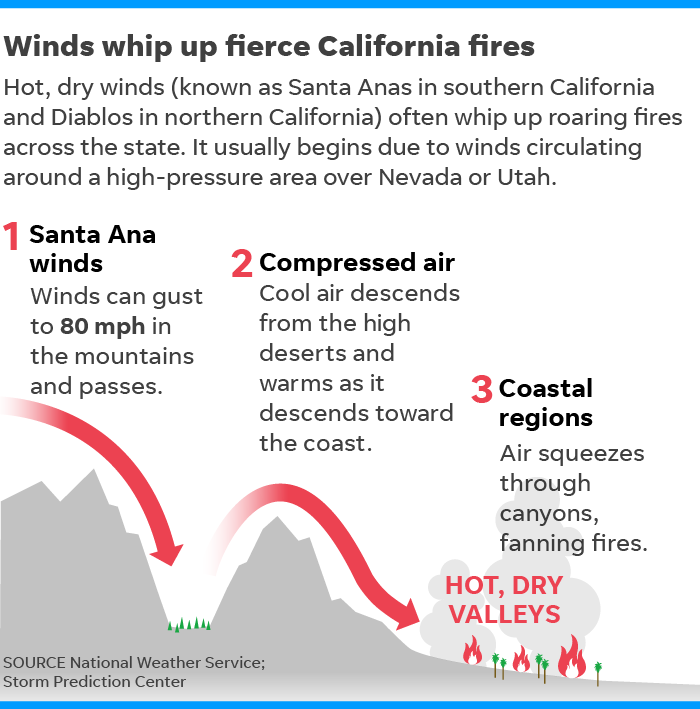Santa Ana winds can be violently unpredictable. However, "mild" SA conditions can give sites like Elsinore lovely ridge lift in the late afternoon & evenings. But how does one know if it is a mild event?
- Look at the gust factors at the site AND surrounding stations 10-15 miles away.
- If the gust factor is 2-3X the base wind, it will not be good, even if the base is light. https://www.sdhgpa.com/weather-stations.html
- Are there opposing wind factors? (those need to be added) A West wind @ 5 meeting an East @ 5 = a wind factor of 10)
- Remember, predicted winds and models do not consider micro environmental factors
- Are the gust factors and predicted gust factors within USHPA recommended flight parameters for your rating?
- Get it wrong and there can be dire consequences. This is one reason that we closed Fuzz.
Simply, Flying Elsinore 500' off the deck parked in even mellow gusty conditions is really not all that fun with a high pucker factor.
Another way to put it: If local hot pilot Chris Cote is not flying due to SA conditions, you should think twice about launching on an SA day. Chris routinely flies bronco air and still doesn't like SA conditions.
The Santa Anas upset that balance, ushering in hot, dry, desert-like conditions. But while the Santa Anas are often called desert winds, the term is misleading; the winds are not simply blowing desert air over Southern California's coastal plain. Instead, Santa Anas result from a cool, dry air mass that hovers over the continental interior of the American West. When that air descends from the higher-elevation basins to sea level, it warms and becomes even drier.
The Devil Wind: A Brief History of the Santa Anas
Have a look at the site you are choosing to fly and imagine the wind flow reversed. Where's the rotor now? What landing options? Any new dangers?
It can be done and can work very well at times, but it's for advanced pilots, not new pilots hungry to fly.
The foothills is where it's the strongest.
On a typical hot SA day it's possible to get a flight on the convergence line(usually the ocean side). I've never personally flown this type of condition.
Today is probably a good day to do some site seeing as the viability is quite good.
As a general guide line, we don't fly our east facing Sites in Santa Ana conditions unless tail end or very mild events. For 80% of Santa Ana condition events, it is likely not a good idea to fly and better to find an alternative activity.
We fly our East facing Sites in katabatic conditions and early day thermal activity with the days switching to convergence flying. Think of and use the East Facing Sites as light wind pure thermal Sites vs windy ridge lift sites.
Fuzz was a rarely used historical launch on the southwest side of the valley (across from the primary Horse Canyon launch site).
Due to the conditions is works in (east winds), it is extremely dangerous and should be considered closed. Fuzz should not be flown in easterly Santa Ana wind conditions. Santa Ana winds and lift tend to be highly unpredictable and often violent.
On Convergence days, it is better to wait for the convergence winds to go to 0 or slightly blowing in on the Horse side of the canyon, then cross the valley with altitude if flying over Fuzz is desired.
Launch at Fuzz is 1/3 height of Horse altitude and ground clearance, as well as being small and unimproved which lead to additional problems.
Most advanced pilots find the risk to reward ratio not worth the effort to launch Fuzz.
Fuzz is closed and use is highly discouraged.
Summary Recap of WX Article from the LA Times: (worth reading the fill LA Times Article)
- Cold Great Basin high pressure airmass flows through the mountains toward low pressure on the coast.
- As the air sinks, it is compressed and warms.
- The air heats up and dries out as it flows down slope over the mountains multiple times.
- Mountain ranges block the air in places as it heads toward the sea. The winds seek openings such as passes and canyons, which accelerate the velocity, creating a venturi effect much like a nozzle on a garden hose.
- Winds can gust from 45 to 100 mph as they squeeze through passes and canyons
- Santa Ana winds (wikipedia)
- What makes the Santa Ana winds blow through Southern California? (LA Times)
- Santa Ana Wind Event Over California (NASA)
- The Santa Ana Winds (UCLA)
- The Santa Ana Winds FAQ (UCLA)
- Why do Santa Anas form and what makes them dangerous? (10 News SD)
- Santa Ana winds explained (CNN video)



 RSS Feed
RSS Feed

